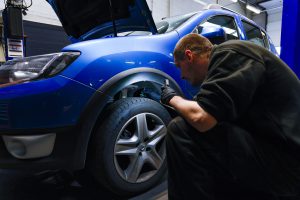There are many ways that car tyres can become damaged, and it’s often harder to spot than you might think. From internal damage and tread wear to poor-quality repairs, there are many hidden tyre problems that may go unnoticed until they become serious.
At Halfords, we stock a huge range of tyres that are suitable for all budgets. Or if your tyre can be safely repaired, pop into your local garage and receive top-quality service from our expert technicians.

Internal Tyre Damage
Often invisible from the outside, internal tyre damage impacts the inner layers and can compromise the overall integrity, safety and road performance of the tyre.
The most common types of internal tyre damage include cord breaks, sidewall or tread separation and bead (the edge of the tyre that sits on the rim) damage. While damage triggered by age is unavoidable, you can extend their lifespan with regular maintenance and avoid potholes and poor road conditions.
When it comes to tyre sidewalls, you need to look out for any visible bumps, cracks or bulges. These all show that there is a weak spot and overall weakened tyre structure.
Some earliest signs of internal tyre damage include vibrations across the steering wheel or entire car, a humming sound, or your TPMS (tyre pressure monitoring system) may light up on the dashboard. In the case of TPMS, we offer a TMPS valve service which is great for whenever you get new tyres fitted and preserving the life of the sensor.
If you suspect internal tyre damage, you should book into your local garage quickly and see a technician for top advice. You may require a replacement tyre, if it can’t be repaired.

Tread Wear
If your tread depth is insufficient, you’re likely to experience issues as your tyres have less grip on the road. This means that your vehicle will struggle with a greater stopping distance and less traction on icy roads. You’re also more likely to aquaplane or even crash in rainy conditions. Your tyres are also more vulnerable to punctures and damage from road debris.
Your tread can wear down secretly and without you noticing as heat and age degrades the rubber. Although, there are steps you can take to maintain the condition of your tyre tread. Avoid poor road conditions, potholes and driving aggressively and your tyres will serve you longer.
The minimum legal tread depth is 1.6mm, although many experts would recommend it should be more than that. You can test your tread at home using a tread gauge or the 20p test. If the outer band of the 20p coin is visible in a tread groove, you’ll probably need to replace the tyre.
You can also take advantage of the Halfords free tyre check where our garage technicians will examine your tyre tread, pressure, and overall condition.
Slow Punctures
A slow puncture in your tyre means that gradually the internal tyre pressure will decrease, eventually leaving you with a flat. Alternatively, you could even suffer a blowout which is likely to cause a dangerous road-side incident. Slow punctures can be caused by debris such as nails, a faulty valve stem or a simple pothole. They’re also easy to miss as they can take weeks to show, often only becoming clear when the tyre goes flat. You should avoid driving with a slow puncture as it’s more likely to speed up the rate of pressure loss.
Some of the early signs of a slow puncture include vehicle vibrations, drifting across the road and a ticking noise.
Technicians will only be able to carry out repairs to certain areas of the tyre, otherwise it’ll need to be replaced.

Improper repairs
Tyre repairs can be tricky, even if carried out by a professional, but botched jobs can seriously put both driver and passengers at risk. Garage technicians are only legally able to repair damage to the minor repair area (or the centre 3/4). If the damage is on the major repair area or the sidewall, the tyre will need to be replaced. That’s because the major repair area is put under more pressure and the repair patches can come loose.
If a puncture is poorly repaired, it compromises the tyre’s structural integrity, leading to slow leaks of air and tyre imbalance. This places your vehicle at a higher risk of experiencing a blow out or even a crash.
At your local Halfords garage, you’ll always receive expert repairs carried out using reliable parts. Plus, all Halfords car parts are quality guaranteed for a minimum of 2 years. Unlock even more benefits and join Halfords Motoring Club to receive 5% off all car repairs at our garages with your premium membership.
Tyre Pressure
Underinflated tyres can cause hidden problems including uneven wear as the rubber sags, heavy steering and a bumpier ride. They’re also likely to worsen your fuel economy as your car has to work harder.
However, overinflated tyres are just as likely to cause the same sneaky issues as above, as well as an increased braking distance and a higher risk of blowouts.
To avoid these hidden tyre problems, you should check your tyre pressure every couple of weeks.
To achieve the correct PSI for your tyre, you should check your car’s handbook. Our Halfords range of pressure gauges and tyre inflators are excellent for pumping up your tyres and getting you where you need to be.
Keeping a close eye on the condition of your tyres, alongside any warning signals displayed, is super important. Make sure that you and your passengers always travel safely by regularly checking your tyres:
- Pressure
- Tread depth
- Overall condition (i.e. punctures)
For all your tyre maintenance and repair needs, visit Halfords today.



